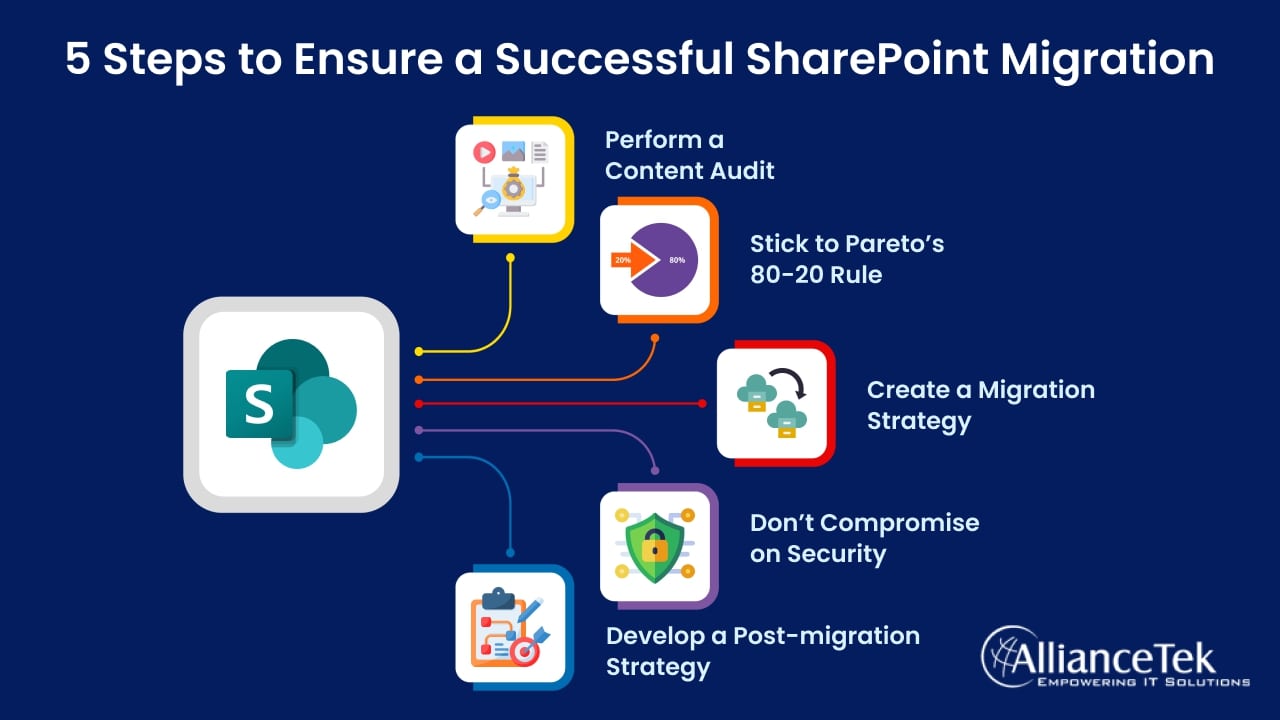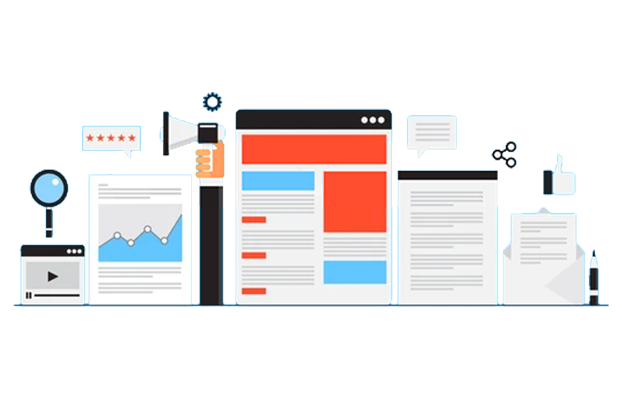SharePoint Online has become an essential tool for many organizations to increase productivity and streamline workflows. With its subscription-based pricing, it has become more accessible to small businesses, and its popularity has skyrocketed due to its ability to break down communication barriers, eliminate duplication of effort, and save valuable time by making it easier to find information.
It’s no wonder that SharePoint collaboration tools are one of the most popular platforms for digital collaboration, business process automation, and file sharing.
However, migrating to SharePoint Online can be a complex process that requires careful planning and execution to ensure a successful outcome. To help organizations navigate this process, we have outlined five steps that can help ensure a smooth and successful migration to SharePoint Online.

Here are the Steps to Ensure a Successful SharePoint Migration
1. Perform a Content Audit
One critical step in preparing for a SharePoint migration is to conduct a thorough audit of the existing environment. This audit should not only focus on the content but also include technical dependencies. Often, companies neglect to clean up outdated content before migrating to SharePoint, hoping to reduce the overall scope of the migration. However, this can lead to unnecessary clutter and difficulties during the migration process.
To avoid such problems, corporations should clarify what content they want to keep and what should be archived before embarking on the migration initiative. This means conducting a detailed inventory of all the data, applications, and infrastructure that are currently in use.
The audit should encompass site collections and settings, sub-sites, content types and site columns, workflows, libraries (including the size and type of content as well as when content was last updated), pages and web parts, and custom solutions (web parts, event handlers, custom coding, etc.).
By conducting a thorough audit, organizations can identify dependencies and potential challenges that may arise during the migration process. This information will help in planning the migration strategy and prioritizing critical content. The audit will also help identify any obsolete or redundant content that can be deleted or archived, reducing the overall size and complexity of the migration.
2. Stick to Pareto’s 80-20 Rule
The Pareto principle, also known as the 80/20 rule, is a concept that applies to various aspects of life, including business management. Essentially, the principle states that roughly 80% of the effects come from 20% of the causes.
This concept was named after Italian economist Vilfredo Pareto, who first noticed the 80/20 connection while at the University of Lausanne in 1896. He observed that approximately 80% of the land in Italy was owned by 20% of the population.
In general business sales management, this principle translates into the idea that 80% of sales come from 20% of clients. When it comes to a SharePoint migration strategy, this principle can also be applied. Specifically, it means that 80% of the staff will use no more than 20% of the content on the intranet.
By identifying this core 20%, organizations can quickly separate the must-haves from items that require more thought, which can further streamline the migration process.
This approach can save a significant amount of time and effort during the migration process by allowing organizations to focus on the most critical content. It can also help prioritize resources and ensure that the most important data is migrated first by identifying and prioritizing this core content, organizations can avoid wasting time and resources on content that may not be as important or may not be used frequently.
3. Create a Migration Strategy
Migrating to a new online collaboration tool can be a daunting task for any organization. One of the significant challenges of implementing a successful migration methodology is aligning people, processes, and systems.
The people aspect of migration is all about communication and collaboration. The process aspect puts a greater emphasis on interactions. The system aspect is about using advanced technological tools optimized for a company's specific circumstances.
When it comes to content migration, there are three main approaches: manual, automated, or a mixture of both.
# Manual Migration
Manual migration is the simplest approach but can be a tedious and time-consuming process. It involves manually transferring content from the old system to the new system, which is not always practical, especially for large amounts of data.
# Automated Migration
Automated migration, on the other hand, involves using specialized tools to migrate content automatically. This approach eliminates the need for resource-intensive manual input, but it requires technical expertise and knowledge of the specific case. Automated migration is often the best option for organizations with a large amount of data to migrate, but it requires careful planning and execution to ensure success.
# Mixture
In most cases, the most effective content migration strategy involves a mixture of manual and automated approaches. This approach allows organizations to take advantage of the strengths of both methods while minimizing their weaknesses. For example, manual migration can be used for critical data that requires more attention to detail, while automated migration can be used for less critical data that can be transferred quickly.
4. Don’t Compromise on Security
Maintaining security policies is a critical consideration for any migration, especially when it comes to sensitive data. Whether using a manual or automated approach, additional diligence must be employed to ensure that all security policies are maintained during the migration process.
In a manual approach, appropriate data validation will need to be performed on migrated data to ensure that sensitive data remains secure. This can include validating access controls, encryption, and other security policies that were in place before the migration. Manual migration requires more attention to detail, and organizations must be vigilant about maintaining security throughout the process.
# Understanding of the Unique Structure
No two custom SharePoint solution migrations are the same. Each business has a unique structure, permissions, workflows, configurations, and metadata, making it critical to have a comprehensive understanding of the existing security policies before starting the migration process. This understanding will help organizations create a detailed migration plan that accounts for all security considerations.
# Settings and Re-evaluation
In-place upgrades may preserve pre-existing security settings and options, but companies still need to take additional steps to ensure corporate security and permissions are preserved, particularly when deploying a migration tool. Migration tools often have their own set of security requirements and configurations, which must be carefully managed to ensure a secure migration process.
In addition to maintaining security policies, migrations and upgrades also provide opportunities for current security parameters re-evaluation. Organizations should take advantage of this opportunity to review their current security policies, identify any gaps or vulnerabilities, and make necessary improvements.
5. Develop a Post-migration Strategy
IT departments understand that real work begins post-migration. Migration is not complete until specific tasks like checking links, cleaning up page layouts, checking user rights, and ensuring security. But even with thorough training and hands-on experience, employees will have questions about unanticipated situations that arise. A robust IT department that can provide individualized support to users will be in the best position to provide this.
The power of SharePoint’s pioneering of a collaborative work culture can only be realized when the tools and Sharepoint features are accepted and implemented uniformly throughout the company. This digital transformation requires a cultural shift in the working style of the organization that will not be possible until employees are convinced that SharePoint is better than legacy systems.
In preparation for a migration to SharePoint 2016, be aware of hardware requirements (for those creating a fresh SharePoint 2016 instance and farm), what version of SharePoint is currently running (if SharePoint 2010, then migrate to SharePoint 2013 first, and check legal and audit implications in case you are going to take advantage of the new cloud features).
Available in January 2018, Microsoft’s SharePoint Migration Tool helps organizations move local SharePoint content in their data centres, such as file shares or document libraries, to SharePoint Online or OneDrive Office 365 services hosted by Microsoft. Support ranges from the smallest of migrations to large-scale migrations with support for bulk scenarios.


